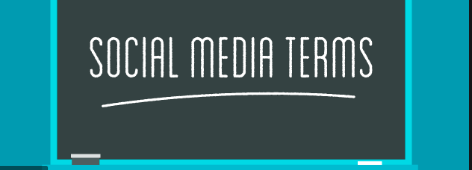Social Media Terms : Part 2 of 7

By Debbie Gregory.
Are you still hung up on the difference between a mention and a reply on Twitter? Do you just want to brush up on your social knowledge? Continuing our ultimate glossary of social media marketing terms with more information to keep you in the know.
Boost, boosted post
A boosted post is a form of social media advertising in which a brand pays to show a social post to people who do not already follow the brand’s social accounts.
Brand advocate
A brand advocate is a customer who loves your brand so much that they promote your products or services without being asked. However, brand advocates can become even more valuable if you connect with them directly to engage and empower them.
Brand Awareness
Brand awareness is a social media metric that captures how likely people are to be aware of your brand. You can measure brand awareness for any given period by tracking the amount of attention your brand gets online in the form of mentions and engagement. The more people are talking about you online, the greater your brand awareness.
Caption
A caption is a description that accompanies a photo on social media. Captions can include text, hashtags, @ mentions, and emojis. Captions are an important part of telling your photo’s story on social media and a key driver of engagement.
Chat
A chat is an online conversation with one or more people. Whether one-on-one or in a group, chats are usually private and text-based, although they may incorporate GIFS, photos, and even audio recordings. Common chat platforms include WhatsApp and Facebook Messenger. “Chat” can also be used to mean a moderated public conversation on social media, organized around a hashtag. Twitter chats, like the monthly #HootChat are a prime example.
Chatbot
A chatbot is a type of bot that uses artificial intelligence to answer questions and perform simple tasks in messaging apps such as Facebook Messenger. A chatbot can be used for customer service, data and lead collection, shopping recommendations, and more.
Check-in
A check-in is a way of location tagging a social media post to indicate where the user is, or where the content in the post was created. It is a way of showing followers that you have physically visited a geographical location or event. It can be particularly useful to check in at large, high-profile events, since it can help people connect in the real world while also providing credibility and demonstrating that you are an insider in your industry.
Clickbait
Clickbait is web content with a misleading or sensationalist headline designed to get readers to click through to the full story, which is generally a disappointment. Clickbait’s goal is usually to generate pageviews and advertising revenue. All social networks have taken a stance against clickbait, and algorithms are designed not to surface clickbait posts. In other words, it’s a practice to avoid.
Click-through rate (CTR)
Click-through rate, abbreviated CTR, is a measure of how many people who view a social post, ad, or other piece of content click through to read more, buy, or take some other action. It is a useful metric because it measures how effectively your social content drives people to your owned web properties. The formula to calculate CTR is number of clicks divided by total impressions. CTR is usually expressed as a percentage.
Comment
A comment is a form of engagement in which a user replies to your social media post. Comments can offer praise, ask a question, express disagreement, and otherwise contribute to the online conversation about your social content. Comments can include text, hashtags, @ mentions, and emojis. Many comments show that your post is engaging and may boost its position in the newsfeed based on a social network’s algorithm.
Community Manager
A community manager is a social media professional who nurtures relationships among a group of social media users so that the community acts on behalf of the common interest. Community managers help develop professional and brand-focused social relationships by monitoring and engaging with fans and followers.
Compliance
Compliance is the practice of understanding and following the rules, regulations, and law. Social media compliance is particularly relevant to organizations in regulated industries like healthcare and finance. These businesses face strict rules governing how they can use social media and how their social content must be archived.
Connection
A connection is someone you or your brand is connected to on social media. LinkedIn specifically uses the term “connections” to refer to professional social relationships—LinkedIn connections are the equivalent of Facebook friends.
Content Curation
Content curation involves collecting relevant content from credible sources and then sharing it with your social followers by linking to the original post. It is a way to create value for your audience beyond sharing your own original content. Sharing resources can also be a good way to build relationships with thought leaders in your field.
Content marketing
Content marketing is the practice of attracting and retaining customers through the creation and distribution of original, valuable content such as videos, whitepapers, guides, and infographics. Consistently providing valuable content gives followers a reason to stay tuned to your social channels while building rapport and establishing your industry expertise.
Conversion
A conversion occurs when a social media user or visitor to your website takes a specific, desired action. Making a purchase is often the desired conversion, but it is not the only one. Other conversion examples include lead-generation actions like opting into a newsletter, registering for a webinar, or downloading a whitepaper.
Conversion rate
Conversion rate is the number of conversions divided by the number of visitors. It’s a social media metric that allows you to measure how well your social media efforts are working to achieve specific business goals.
Cost per click (CPC)
Cost per click (CPC) is a metric for how much each click costs in a pay-per-click advertising campaign. Cost-per-click and pay-per-click are sometimes used interchangeably, but they are actually two sides of the same coin. Pay-per-click is the type of ad model, and cost-per-click is the fee per click.
Creative Commons
Creative Commons is a non-profit organization that provides licenses and other legal tools to allow photographers and other content creators to share their work. There are more than 1.6 billion works in the Commons, which can be shared in various ways. The six levels of Creative Commons licenses restrict how an image or other content can be used, and whether attribution is required.
Creep
To “creep” is essentially to stalk a person or a brand on social media, especially without engaging with any of their posts. Despite the negative word, it is not always a negative thing. Creeping can also be a form of online research, for instance, when screening potential new employees.
VAMBOA hopes that our audience is enjoying this series. Stay tuned for part 3. You might want to print this out as a glossary.











